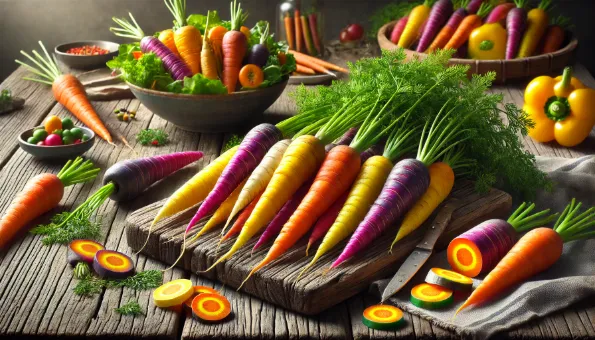Rainbow Carrots: Colors, Nutrition, and Uses
Rainbow carrots bring beta-carotene, fiber, and extra antioxidants from purple, yellow, and red pigments.

Introduction
Rainbow carrots are varieties of carrots in purple, yellow, red, white and traditional orange. Their different pigments add unique phytonutrients—**anthocyanins** in purple, **lutein** in yellow, and **lycopene** in red—on top of classic beta-carotene.
Nutritional Value (per 100 g, raw)
| Nutrient | Amount |
|---|---|
| Energy | 41 kcal |
| Carbohydrates | 10 g |
| Sugars | 4.7 g |
| Fiber | 2.8 g |
| Protein | 0.9 g |
| Fat | 0.2 g |
| Vitamin A (RAE) | ~835 µg |
| Vitamin C | ~6 mg |
Benefits
- **High in fiber** for digestive health
- Rich in **provitamin A carotenoids** for normal vision and immunity
- Colored varieties add **anthocyanins, lutein, lycopene** with antioxidant activity
- **Low-calorie**, hydrating and versatile
Potential Drawbacks
- Very high carrot intake may temporarily tint the skin (**carotenemia**), harmless and reversible
- Some nutrients (vitamin C) can decrease with overcooking
Culinary Uses
Roast, sauté, steam, pickle, spiralize, or eat raw. Toss roasted rainbow carrots with olive oil, lemon and herbs, or shave thin for salads and slaws.
Tips & Varieties
- **Purple**: anthocyanins; great for pickling (color pops)
- **Yellow**: mild, sweet; high in lutein
- **Red**: lycopene; delicious roasted
- Light cooking with a little **fat** can improve carotenoid absorption
Fun Fact
Carrots weren’t always orange—historically many were purple or yellow; orange became popular in Europe later.
- 1. Rainbow Carrots
šarene mrkve (ljubičaste, žute, crvene, bijele) bogate vlaknima i fitonutrijentima

